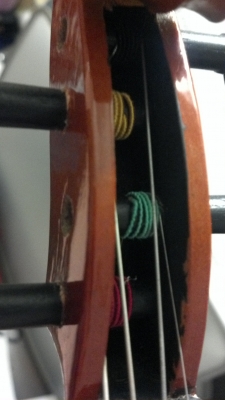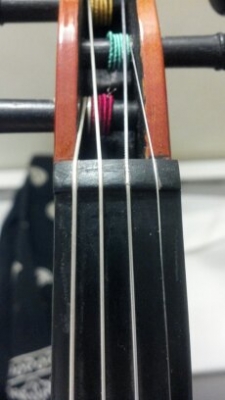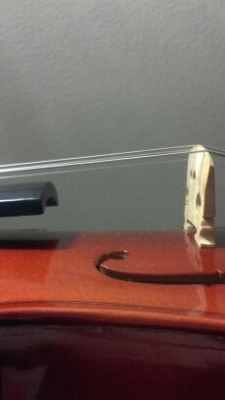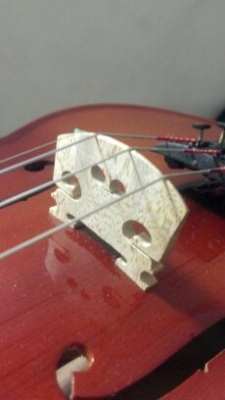Welcome to our forum. A Message To Our New and Prospective Members . Check out our Forum Rules. Lets keep this forum an enjoyable place to visit.
Currently working on errors from the latest (SimplePress) forum update. Many issues have been resoled and others are being worked on. Thank you for your patience.
 Topic RSS
Topic RSS



 (0 votes)
(0 votes) Regulars
 Offline
Offline

So, I have occasionally been shifting to 3 position. (Probably too early to do so, but I like to familiarize myself with new things and I'm trying to keep things loose and myself from death-gripping the violins neck)
I don't really enjoy shifting because whenever I do so, none of the notes that sit above the fourth finger in first position will come out clear (except for the E string), even when the tuner says I'm playing the correct pitch.
It that an instrument problem (mine was cheap), or am I doing something wrong on the bowing part? Since I'm a beginner I tend to blame myself.
Any thoughts?
It's easy to play any musical instrument: all you have to do is touch the right key at the right time and the instrument will play itself. Johann S.Bach
Regulars
 Offline
Offline

I have been using my tuner to make sure I am hitting the right note too. The sound is not as strong in the other positions - shorter strings = less sound?
Violinist start date - May 2013
Fiddler start date - May 2014
FIDDLE- Gift from a dear friend. A 1930-40 german copy, of a french copy of a Stradivarius. BOW - $50 carbon fiber. Strings - Dominants with E Pirastro Gold string.
Regulars
 Offline
Offline



Regulars










Honorary advisor
Regulars
 Offline
Offline







 Offline
Offline
Regulars
 Offline
Offline

Is it Sunday already?
Thank you everyone!! @mischa91 No, I really haven't checked the cut of the bridge I don't even have a clue how to, lol. But I measured the height of the bridge right in the middle and it's 3.1 cm. (The other one that came with it is even higher.)
Jim Dunleavy said
... when you play in higher positions the optimum bowing position moves nearer the bridge.
Crazymotive said
I would second the above comment. If you are playing higher positions watch your bowing. As you shift higher you need to play closer to the bridge. You may also need increased bow pressure. It takes practice and time and is an art as well as a science. In time you'll get it right.
I tried to to that after I read your responses, it did change it somewhat, but not a lot.
@fiddlerman, the instrument was rather cheap, if I paid 150 for it is was a lot, not any of the wood on it is ebony. I can't even remember what the make or the model of it is, there isn't any stamp or sticker in it either.
As far as the rest, I don't have any idea how or where to measure, but as I said above the bridge is about 3.1 cm high in the middle.
The rest I measured at the end of the fingerboard and :
G string 5 mm
D string 4.5 mm
A string 4 mm
E string 3 mm
(for some reason when I put the strings on it kind of ruined the a string on the top. There also doesn't seem to be any clearance between the e string peg and the a string coming over, seem like there should be)
Here are some pictures:





It's easy to play any musical instrument: all you have to do is touch the right key at the right time and the instrument will play itself. Johann S.Bach
Regulars
 Offline
Offline



Best way to check it is to take it to a luthier and have them check it. The strings look high off the finger board from what I can see so the bridge might be too high; if the instrument was a cheaper one then the bridge likely needs to be recut.
A good way to see is to put your left hand at third position, place say your second or third finger on the A or D string, press down. Then look at the end of the finger board closest to the bridge, what do the strings look like? Does the string you pressed look lower than the others? If so your bridge is likely too high.
I had to have my mine cut down on my acoustic and took my electric in just last week to have a new bridge fitted to that too.
Regulars
 Offline
Offline

Thank you so much for the information @mischa91 and @Fiddlerman
mischa91 said
Best way to check it is to take it to a luthier and have them check it.
Unfortunately, I haven't been able to find any luthiers around here.
_____
Wow, if you can see from just a picture that the bridge is way too high... that explains a lot of things, like why my fingers won't get past being sore.
Unfortunately, I've found more issues with this violin the end pin is loose as well, when I pulled it out I peeked in the hole and saw there was some space under the sound post as well.

 (I'm saving for a 'real' violin)
(I'm saving for a 'real' violin)
(I guess the positive side on this is, it might not be my fault after all I can get the sounds out nicely on the higher end notes )
)
It's easy to play any musical instrument: all you have to do is touch the right key at the right time and the instrument will play itself. Johann S.Bach
Regulars
 Offline
Offline

Fiddlestix said
@AnnyJ: I would think that, if you can see a space under the sound post it shouldn't be standing. Perhaps it's not cut right and the post is only touching on one edge and in very tight. Especially if you have the end pin out, there's no pressure on the post to keep it wedged in.Ken.
Yes, you're right!
On another note, I surprisingly got my old violin from home in the mail on Tuesday, the bridge is a hell of a lot lower than on the one I've been playing on and it sounds much better in the higher positions. 
But it has the exact same issue with the sound post.
(where did the math problems go?)
It's easy to play any musical instrument: all you have to do is touch the right key at the right time and the instrument will play itself. Johann S.Bach
Regulars







@AnnyJ
There are several things you could do to lower your strings yourself since you can't find a luthier in your area:
1. take all strings off, put a sand paper on your violin where your bridge would go facing up, put your bridge on top and go back and forth (nut to saddle direction), looks like you could sand your bridge 1 mm lower. You may need a tool for this if you don't have steady hands. You could start with 100 grits so it go faster, but towards the end use fine sand paper. You could also sand from the top of the bridge to lower it, then you will need to cut the grove. Your bridge looks too thick as well so you could also sand it down.
2. sand your nut down, but it does not look like you have ebony nut, so I would only do that when your stings are cutting into the nut.
3. do both 1 and 2 to get the right height.
as for sound post, you could buy a sound post tool from fiddlershop and follow fiddlerman's video instruction to reset it. You may need to have a new sound post, I believe fiddlershop carries it, too. You could cut one using a sharp new exactor knife, also follow fiddlerman's video instruction. Usually a sound post material comes in length enough for three or four sound posts, so I am sure you could cut a right one out of it.
Even though your violin like you said it's a cheap one, but it's always nice to have a second one - take it to camping trip, hiking, when the other is in the shop, etc. It is also helpful to know how to set your sound post and adjust your bridge.
by the way, end pin is never glued on, it's supposed to be loose.
Honorary advisor
Regulars
 Offline
OfflineI had this similar problem before as well...
a solution is to play long bow strokes and use a full vibrato. What this does is literally break-in the instrument. The vibrations will help open up the sound so that those wolf notes sound more crystal clear rather than muted...
...Should take a few days of doing this before you really notice the improvement, just think of it as sound shaping while vibrato practicing!
Regulars
 Offline
Offline

@damfino I guess now I'm going to have to be extra careful where the mouse pointer is so I don't accidentally click to post a half written post with this moody computer, lol
@pky wow, thank you for the information!! I've just watched the video(s) it's very daunting to me. Maybe now that I have my bridge-me over violin, I can use the other one for a guinea-pig. You're absolutely right that it's good to know how to do these things with no availability of a luthier around, God forbid if my soundpost ever fell over, I'd be in trouble.
@jacques thank you! that is very insteresting, I had know idea that one could do that to help the sound of the violin. Unfortunately, I can't do vibrato.
It's easy to play any musical instrument: all you have to do is touch the right key at the right time and the instrument will play itself. Johann S.Bach
@pky wow, thank you for the information!! I've just watched the video(s) it's very daunting to me. Maybe now that I have my bridge-me over violin, I can use the other one for a guinea-pig. You're absolutely right that it's good to know how to do these things with no availability of a luthier around, God forbid if my soundpost ever fell over, I'd be in trouble.
Anny, if you are brave to try, you could even get ebony nut and ebony finger board and replace the old one on it. My teacher gave me a 1/2 size violin to use as a guinea pig. I changed the nut, fingerboard, soundpost, bridge, pegs, strings, and the fittings on it, and I kind of reshape the neck as well. It sounded better, not top notch. But I had a lot of fun doing it. Have fun!
1 Guest(s)


 Log In
Log In Register
Register
















